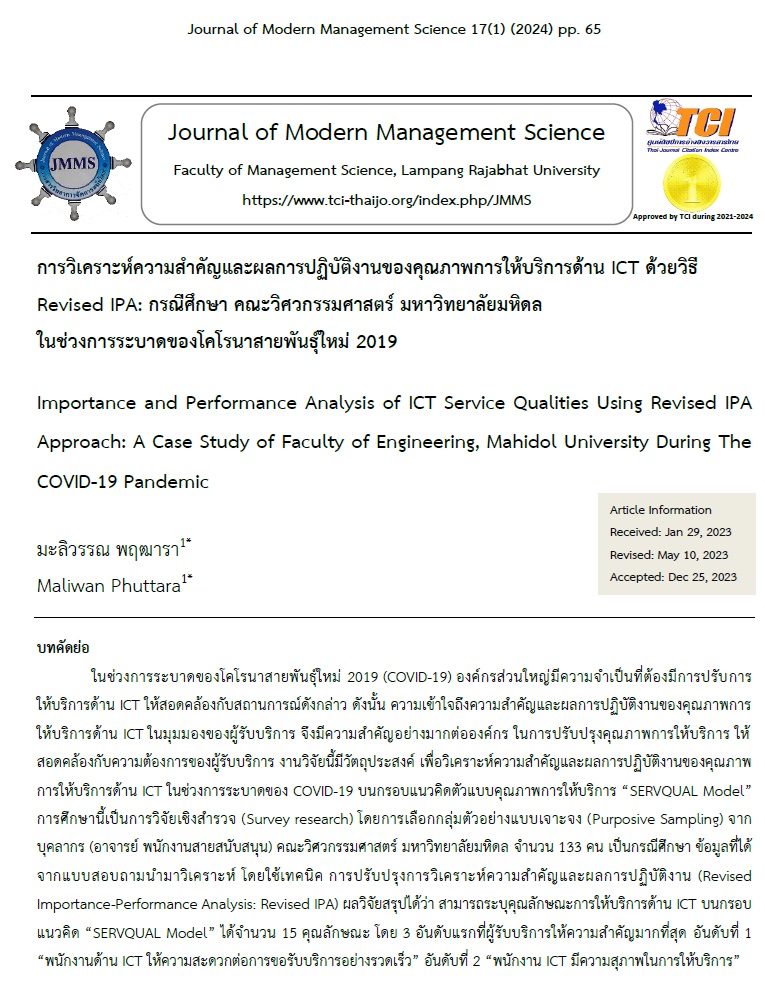การวิเคราะห์ความสำคัญและผลการปฏิบัติงานของคุณภาพการให้บริการด้าน ICT ด้วยวิธี Revised IPA: กรณีศึกษา คณะวิศวกรรมศาสตร์ มหาวิทยาลัยมหิดล ในช่วงการระบาดของโคโรนาสายพันธุ์ใหม่ 2019
Main Article Content
บทคัดย่อ
ในช่วงการระบาดของโคโรนาสายพันธุ์ใหม่ 2019 (COVID-19) องค์กรส่วนใหญ่มีความจำเป็นที่ต้องมีการปรับการให้บริการด้าน ICT ให้สอดคล้องกับสถานการณ์ดังกล่าว ดังนั้น ความเข้าใจถึงความสำคัญและผลการปฏิบัติงานของคุณภาพการให้บริการด้าน ICT ในมุมมองของผู้รับบริการ จึงมีความสำคัญอย่างมากต่อองค์กร ในการปรับปรุงคุณภาพการให้บริการ ให้สอดคล้องกับความต้องการของผู้รับบริการ งานวิจัยนี้มีวัตถุประสงค์ เพื่อวิเคราะห์ความสำคัญและผลการปฏิบัติงานของคุณภาพการให้บริการด้าน ICT ในช่วงการระบาดของ COVID-19 บนกรอบแนวคิดตัวแบบคุณภาพการให้บริการ “SERVQUAL Model” การศึกษานี้เป็นการวิจัยเชิงสำรวจ (Survey research) โดยการเลือกกลุ่มตัวอย่างแบบเจาะจง (Purposive Sampling) จากบุคลากร (อาจารย์ พนักงานสายสนับสนุน) คณะวิศวกรรมศาสตร์ มหาวิทยาลัยมหิดล จำนวน 133 คน เป็นกรณีศึกษา ข้อมูลที่ได้จากแบบสอบถามนำมาวิเคราะห์ โดยใช้เทคนิค การปรับปรุงการวิเคราะห์ความสำคัญและผลการปฏิบัติงาน (Revised Importance-Performance Analysis: Revised IPA) ผลวิจัยสรุปได้ว่า สามารถระบุคุณลักษณะการให้บริการด้าน ICT บนกรอบแนวคิด “SERVQUAL Model” ได้จำนวน 15 คุณลักษณะ โดย 3 อันดับแรกที่ผู้รับบริการให้ความสำคัญมากที่สุด อันดับที่ 1 “พนักงานด้าน ICT ให้ความสะดวกต่อการขอรับบริการอย่างรวดเร็ว” อันดับที่ 2 “พนักงาน ICT มีความสุภาพในการให้บริการ” และ อันดับที่ 3 “พนักงานด้าน ICT มีความเต็มใจในการให้บริการ” จากการวิเคราะห์ข้อมูลด้วย Revised IPA สามารถจัดกลุ่มคุณลักษณะการให้บริการด้าน ICT ออกเป็น 4 กลุ่ม ได้แก่ กลุ่มที่ 1 คือ “ทำดีแล้วรักษาไว้” (Keep up the good work) มีจำนวน 6 คุณลักษณะ ได้แก่ (1) ความรู้และทักษะในการแก้ปัญหาได้อย่างมีประสิทธิภาพ (2) การตอบสนองต่อการขอรับบริการอย่างรวดเร็ว (3) ความเต็มใจในการให้บริการ (4) ความสะดวกต่อการขอรับบริการอย่างรวดเร็ว (5) ความไว้วางใจต่อการให้บริการ และ (6) ความสุภาพในการให้บริการ กลุ่มที่ 2 คือ “เพ่งความสนใจ” (Concentrate Here) มีจำนวน 1 คุณลักษณะ ได้แก่ “ความพร้อมและคุณภาพของ Hardware พื้นฐานที่จำเป็น” กลุ่มที่ 3 คือ “ลำดับความสำคัญต่ำ” (Low Priority) มีจำนวน 4 คุณลักษณะ ได้แก่ (1) ความพร้อมและคุณภาพของ Software พื้นฐานที่จำเป็น (2) ขั้นตอนการขอรับบริการด้าน ICT ไม่ยุ่งยาก (3) รายละเอียดขั้นตอนของการให้บริการด้าน ICT มีความชัดเจน และ (4) ประสิทธิภาพของการให้ความช่วยเหลือผ่านระบบ helpdesk สำหรับ กลุ่มที่ 4 คือ “มีโอกาสล้มเลิก” (Possible Overkill) มีจำนวน 4 คุณลักษณะ ได้แก่ (1) ขั้นตอนการบริการ มีความถูกต้องแม่นยำ (2) การแก้ปัญหาตรงเวลาที่กำหนดไว้ (3) ความยืดหยุ่นในการให้บริการ และ (4) ความเอาใจใส่ในการให้บริการ โดยผลงานวิจัยนี้ องค์กรกรณีศึกษา สามารถนำไปใช้ในการปรับปรุงการบริการด้าน ICT ในช่วงการระบาดของ COVID-19 ให้สอดคล้องกับความคาดหวังและความพึงพอใจของผู้รับบริการ
Article Details

อนุญาตภายใต้เงื่อนไข Creative Commons Attribution-NonCommercial-NoDerivatives 4.0 International License.
บทความจะต้องผ่านการพิจารณายอมรับให้ตีพิมพ์ได้โดยกองบรรณาธิการของวารสารการจัดการ คณะวิทยาการ มหาวิทยาลัยราชภัฎลำปาง และได้รับการตรวจอ่านโดยผู้ทรงคุณวุฒิ(Peer review) และผู้เขียนบทความต้องปรับปรุงตามข้อเสนอแนะหากมีก่อนตีพิมพ์ บทความที่ไม่ผ่านการพิจารณา กองบรรณาธิการจะแจ้งให้ทราบผลการพิจารณา แต่จะไม่ส่งต้นฉบับคืนผู้เขียน
วารสารวิทยาการจัดการสมัยใหม่ คณะวิทยาการจัดการ มหาวิทยาลัยราชภัฏลำปาง ตีพิมพ์เผยแพร่ทั้งฉบับพิมพ์และฉบับออนไลน์ เราอนุญาตให้นำบทความไปใช้ประโยชน์ทางวิชาการได้ ภายใต้ขอบเขตของกฏหมายลิขสิทธิ์
เอกสารอ้างอิง
Asiamah, N., Frimpong Opuni, F., Aggrey, M., & Adu-Gyamfi, K. (2021). ADAPTED SERVQUAL: A Health Service Quality Scale Incorporating Indicators of Sanitation and Hygiene. Quality Management in Health Care. 10.1097/QMH.0000000000000269.
Farooq, M. S., Salam, M., Fayolle, A., Jaafar, N., & Ayupp, K. (2018). Impact of service quality on customer satisfaction in Malaysia airlines: A PLS-SEM approach. Journal of Air Transport Management, 67, 169–180. https://doi.org/10.1016/J.JAIRTRAMAN.2017.12.008
Hsu, S.W., Qing, F., Wang, C.C., & Hsieh, H.L. (2018). Evaluation of service quality in Facebook-based group-buying. Electronic Commerce Research and Applications, 28, 30–36.
Kang, D., Jang, W., & Park, Y. (2016). Evaluation of e-commerce websites using fuzzy hierarchical TOPSIS based on E-S-QUAL. Applied Soft Computing Journal, 42, 53–65. https://doi.org/10.1016/j.asoc.2016.01.017
Kano, N., Seraku, N., akahashi, F., & Tsuji, S. (1984). Attractive quality and must-be quality, transition from “Hinshitsu” quality. Journal of The Japanese Society for Quality Control, 14 (2).
Martilla, J.A., & James, J.C. (1977). Importance-performance analysis. Journal of Marketing Theory and Practice, 41 (1),77–79.
Mathong, P., Sureeyatanapas, P., Arunyanart, S., & Niyamosoth, T. (2020). The assessment of service quality for third-party logistics providers in the beverage industry. Cogent Engineering, 7 (1),1-17. 1785214. https://doi.org/10.1080/23311916.2020.1785214
Mejia, J., Mankad, S., & Gopal, A. (2021). Service quality using text mining: Measurement and consequences. Manufacturing & Service Operations Management, 23 (6), 1354–1372.
Mohammad, A., Kayvan, A., Javad, E., & Chris, D.G. (2022). Importance – Performance Analysis (IPA) of metro Service Attributes during the COVID-19 pandemic. Case Studies on Transport Policy, 10, 1661-1672, doi.org/10.1016/j.cstp.2022.06.005.
Parasuraman, A., Zeithaml, V.A., & Malhotra, A. (2005). E-S-Qual: A Multiple-Item scale for assessing electronic service quality. Journal of Service Research, 7 (3), 213–233.
Rotar, L., & Kozar, M. (2017). The use of the Kano model to enhance customer satisfaction. Organizacija 50 (4).
Sever, I. (2015). Importance-performance analysis: A valid management tool? Tourism Management, 48, 43–53.
Suh, Y., Woo, C., Koh, J., & Jeon, J.(2019). Analyzing the satisfaction of university–industry cooperation efforts based on the Kano Model: a Korean case. Technology Forecast and Social Change, 148, https://doi.org/10.1016/j.techfore.2019.119740.
Suria, H., Ahmad, F. M., & Siti, N. S. (2019). Bus service indicator: The different sight of performance index development. Journal of Physics: Conference Series, 1349(1). https://doi.org/10.1088/1742-6596/1349/1/012049
Yamane, T. (1973). Statistics: An Introductory Analysis. 3rd Edition, Harper and Row, New York.
Zhang, J., Lu, X., & Liu, D. (2021). Deriving customer preferences for hotels based on aspect-level sentiment analysis of online reviews. Electronic Commerce Research and Application, 49, https://doi.org/10.1016/j.elerap.2021.101094.


